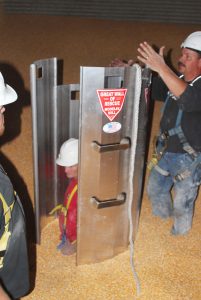To understand the risks of a confined space and what working in one will entail, personnel must first understand what a confined space is and why it matters.
A confined space is defined as an area with limited openings for entry and exit, with an environment that is not conducive or unfavorable towards good ventilation. Employees are not expected to remain in the space continuously or for long-term occupancy.
Typically, a person can fit into space, but there is still limited egress and entry. It’s not an area specifically designed to work in, and it’s against OSHA standards to hold workers within one for prolonged periods. Some confined spaces can be dangerous—there is the potential for workers to suffocate if it contains hazardous fumes or material that could engulf the worker.
What are good examples of a confined space?
Utility tunnels, septic tanks, grain bins, sewage tunnels, underground vaults, storage tanks, and other similar environments are good examples of confined spaces. While a worker may need to go in there to do some maintenance or make adjustments, workers should never be in them for prolonged periods and get out as soon as possible. Some confined spaces may even need specific OSHA-required permits or regulations.
What are the dangers in a confined space?
Suffocation, entrapment, oxygen deficiency, or the presence of flammable and explosive atmospheres are just some of the high risks involved with working in a confined space.
Furthermore, if the space contains flowing liquid or free-flowing solids (storage tanks and grain bins are good examples), the material can flow into the space and cause the worker within it to drown. Another significant risk is excessive heat. The temperature within a confined space could rise significantly, increasing the risk of heatstroke or cause a worker to collapse within the confined space. It would then be extremely difficult or impossible to extract them from the space.
Working in confined spaces or needing to go into one is inevitable in many industrial industries. But by understanding what the area is and the dangers it poses, workers can keep safety protocols in mind and remember why they need to abide by them.
KC Supply takes worker safety seriously, especially in confined spaces. See more safety equipment and information for industrial workers in KC Supply.



 Grain handling can be a precarious business, as people in the agricultural industry well know. There are various hazards and dangers in handling, and accidents have been significant (and fatal) enough that OSHA has its section for the matter. Here’s what you need to know to get started on grain safety.
Grain handling can be a precarious business, as people in the agricultural industry well know. There are various hazards and dangers in handling, and accidents have been significant (and fatal) enough that OSHA has its section for the matter. Here’s what you need to know to get started on grain safety. 